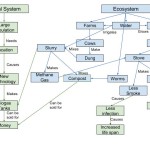When considering the topics from module two, I think about the types of feedback loops and how they are incorporated in my diagram. Examples of positive feedback loops occur when more money leads to more education, which leads to more technology. These are both good things for any social system. Also, more cows produce to more dung, which can be combined with water to make more slurry. The slurry makes more methane gas for cooking, and compost, which can be sold for money. Examples of negative feedback loops occur when the methane gas is used for cooking, which reduces smoke and infection in humans and the environment.
Making methane gas and using it for fuel is much more sustainable than cutting down trees, and wasting time gathering wood. Dung from livestock will always be available, so there will always be a source of energy to cook with. This is very important, especially in developing nations and nations with large populations.
There are several similarities between my diagram and the Marten diagram from the reading. They include population, knowledge/education, and technology on the social systems side, and plants, animals, and water on the ecosystem side. Differences include more detailed breakdowns of what each of those similarities produce. These differences occur because my diagram is about a specific human invention, whereas Marten’s is about the basic interaction. We can learn that each of the interactions listed in Marten’s diagram have many additional parts that make the relationships much more complicated.

